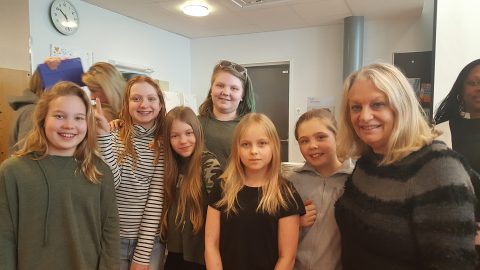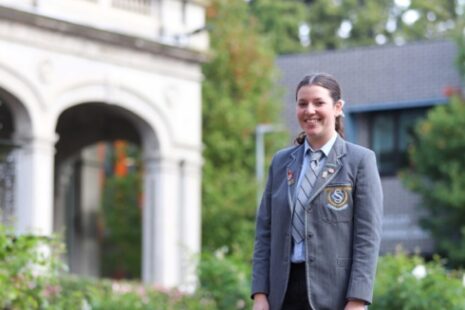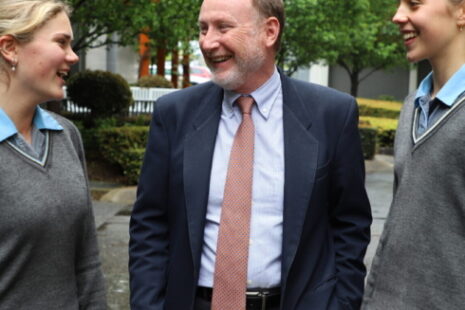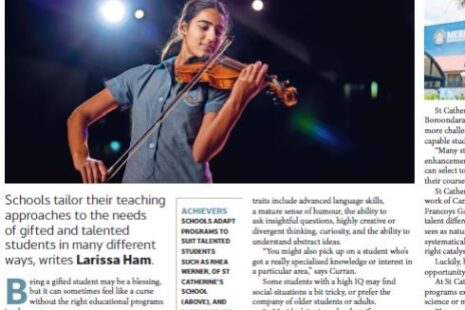Lessons from Finland

There is little debate among people, about the importance of education for future success. However, while there is a consensus about the importance of education for one’s future, there is little consensus on what makes the best education?
Currently, our national discourse is deeply divided as to how we ensure the best possible educational outcomes for students. Is it about the amount of funding? Do we need a new funding model? Should it be needs based? What is the definition of needs? Do we test more? Do we test less? Are our teachers to blame or are they simply maligned because they are at the grass roots of where education takes place?
Perhaps the emphasis is misdirected? Should we be asking different questions? Do we need a paradigm shift in our thinking about what constitutes the best education? Whatever the case may be, we certainly need answers. If we take into consideration our PISA results, (Program for International Student Assessment), the measure used globally by 72 counties, including Australia, then we have cause for serious concern. The 2015 PISA World Ranking results showed that Australian students are doing worse in reading, maths and science in real terms and in comparison to other countries, and are now just above the Organisation for Economic Co-operation and Development (OECD) average.
The 2015 Trends in International Mathematics and Science Study (TIMSS) report found that Australia has seen little improvement in these areas since 1995, and last year’s NAPLAN results, found that literacy and numeracy results have flat lined. The findings cause significant concern, for any parent, teacher, or school principal. The pervasive question here, is why?
Perhaps we can learn some lessons from Finland. Unlike Australia, Finland does not conduct National Testing, students do not have homework, they start school at age 7, although all children must attend kindergarten. Children spend less time in school than their Australian counterparts, and despite this, Finns rate in the top 5 countries in the PISA rankings, for the last decade.
Recently, I was invited to visit Finnish Schools with 22 US educators. Our visits were limited to the Southern part of Finland, where the vast majority of schools are located.
My first visit was to a Junior School, 1 and half hours out of Helsinki, in Tuusula. The school was, close to a snow-filled forest, there was a lake nearby. As we entered the school, students waved hello. Teachers smiled. Bikes neatly positioned in rows, helmets hanging from their handlebars. Shoes neatly placed in shoe-racks, shoes are never worn inside at any school and at any age. As we entered the school, it was calm almost serene. Some students sat on colourful plastic balls, others sat on couches, some at their desks, and this was replicated in every classroom. We discovered some Year 5 students measuring the corridors for a Maths lesson. The bell rang and students and teachers sat together in the canteen eating their morning snacks, in animated conversation. Students played outside, a practise we observed every 45 minutes.
We moved to the Arts and Crafts classrooms; girls and boys were doing woodwork, ironing clothes and sewing pillow slips, in this instance. Students were engaged and clearly enjoying what they were doing. And, so were the teachers. Later we spoke to the Principal who contextualised what we had observed. The school uses the local surroundings for learning. The lake is used for informal education, team-building, fishing. You see the Finns believe that education should fundamentally be about life-skills. Their focus is not on grades or scores but ensuring their children are happy and confident life-long learners. Their education includes the basic skills of Literacy and Numeracy, Arts and Crafts, Swedish, Lappish and English, but also extends to self-efficacy, self-determination, self-confidence and the importance of personal responsibility.
As we travelled to a Comprehensive Secondary School, this time in Suutarila. Once again, we were welcomed by smiling faces; shoes carefully placed in shoe racks, however, this time; we also saw motorbike helmets. The principal spoke to the group and showed us the new school buildings that will commence construction in a few months. All members of the school community had input. Students even had an experimental room to test out furniture, the acoustics and floor coverings. Students voted on their preferences and were included in the final design.
The Principal, shared one of the reasons behind the success of Finnish Schools. He explained, that Well-being Committees, operate in every school in Finland. The committees meet fortnightly. Teachers, therapists, the school councillor, the Principal and Special Education teachers work collaboratively to meet students’ learning needs. He then took us to a ‘pullout’ classroom of Year 8 and 9 students. The classroom was created as a direct result of recommendations made by the Committee. Why a pullout classroom? Anxiety and depression hampered the students’ ability to learn in the mainstream classroom. A psychiatric nurse, psychologist and teacher worked with these students. I asked a few how they felt about the concept of the pullout classroom. They said they loved it. “This was the only way I can come to school,” said Marja. Other students spoke of how they were able to make friends, and, that their teachers had a deeper understanding of their needs. They were quick to point out they had to do school work and what is more they managed to do it. The day of my visit, the students were making smoothies for the canteen, which earnt them additional dollars for excursions to favourite venues.
Once again, lunch is served in the canteen and teachers joined students in casual but respectful conversation. When students leave for the day at 2.30pm, they play competitive sports, or go home to an empty house and prepare meals or do chores, a far cry from Australian after school activities! Families join at the end of the day for family time, no homework.
Once the students leave in the afternoon, we observed teachers working together, planning curriculum tailored to the learning needs of their students. Teachers were animated, engaged and purposeful about planning for their students and this they did for two hours every single teaching day.
Finns talk about education starting from the ‘womb’ and continuing through adulthood. Finland provides an excellent education no matter your learning needs or age. Parenting classes are compulsory, and once through school, there are adult education learning opportunities. In fact, 80% of Finns participate in adult learning. Education is considered a life-long endeavour.
Since the 70s, teachers must have a Master Degree before setting foot in the classroom, and only the top 10% of graduates are accepted into teaching. Teachers teach for life. They are trusted and respected. They earn salaries closely commensurate to that of lawyers and doctors. Educators inform government about educational reforms, not politicians or bureaucrats. If the government changes, educational directions do not. Funds are distributed from the government to Municipalities. Principals submit budgets to the municipalities based on the needs of the students in their schools. Taxes fund education, the more you earn the more tax you pay. Here we start to see some distinctions between Finland and Australia. But is it merely a question of funding?
In 2016, Finland brought in a New Curriculum. The University of Helsinki is a co-partner in its development. Principals and teachers had direct input into the New Curriculum. It is currently being trialled and its roll out will be slow and methodical. The New curriculum has greater emphasis on informal education. More often than not, students learn outside the four walls of the classroom, visiting their local environment, museums, the Heureka interactive Science Centre (schools are required to take students annually) and virtual reality worlds. Finnish education aims to connect students with real world problems in real-world contexts.
STEM Education (Science, Technology, English and Mathematics) has been a significant influencer in Finland’s new curriculum. Art has now been included: changing the acronym from STEM to STEAM. Increasingly, subjects are merging, rather standing alone. Project based work will become a feature. The new curriculum, also values the importance of time and space: time to learn, learning spaces to enhance the overall learning experience. Healthy living: nutrition and physical education are also emphasised. Mindfullness is practised daily to ensure healthy minds. Will the new curriculum impact on Finland’s PISA rankings? Only time will tell.
While Finland respects and values its teachers, it is the students that are most respected. Students set learning goals alongside teachers. No test scores are discussed in class. There are no rankings of schools. But there is a focus on individual development. Students are tested at the end of every unit of work, but they are tested on what they have been taught.
Teachers encourage students to make their own choices for electives in Years 7-12. No parent is permitted to influence this (this is an agreement between parent and the school). Students learn the impact of choices even in the early years and learn to live with them.
Student voice is valued and given expression through student councils. This is not tokenism, as their voices feed into Senior School Leadership meetings and influence a range of area such as: learning spaces and their construction, choice of classroom furniture, cafeteria food, environmental subjects and electives on offer.
A stark difference between Australia and Finland relates to its Upper Secondary education in Years 11 and 12. Students have three choices:
Firstly, they can undertake Comprehensive Education which is the equivalent of our VCE. Unlike Australia, there are no exams in Year 11, only Year 12. Completing a Comprehensive Education is a direct pathway into university. A second option for students is taking up a Vocational placement, specialising in a trade of their choosing. There is a vast array of choices for students and it is in high demand. The Vocational training Centres are excellent and there is no stigma associated with this choice. Upper Secondary students also have a third option. They can take up both Vocational and Comprehensive studies. Adult education provides pathways for adult students to progress through the equivalent of our VCE, opening up the possibility of entering university in their adult years.
Pathways for students in Australia are similarly opening up for our students. However, in an article written by Pallavi Singhal for Fairfax Media, she interprets our PISA Ranking quite differently. She highlights that Australian student aspirations, to undertake a university degree, are higher than those in Finland, but so too are their anxiety levels, with 1:4 adolescent students experiencing high levels of anxiety and depression.
Are we testing too much? Are we limiting choices for our Years 11 and 12 students? Do we need more high calibre vocational institutions?
Sue Thomson, the Director of Educational Monitoring and Research at the Australian Council for Education Research, suggests that vocational training does need attention. She claims the ‘low popularity of vocational education’ is a cause for concern, highlighting that “that only 3 per cent of Australian students aim to do a VET course compared with an average of 15 per cent of students in OECD countries”.
Is Finland perfect? Does it have its challenges? Of course. A significant number of 16-24 year olds are not studying or working (these are youth mainly from North), in the Arctic Circle. Finland, along with many European countries, is grappling with the integration of a large number of refugees. Girls outperform boys and women are very independent. Divorce rates are also high.
There is no perfect society or educational system. As I see it, Finish Education is a cultural phenomenon. It sits at the core of its society’s d’etre. Education is valued in every sector of the community. Education is inclusive and equitable. Its starts in the womb and is life-long. Student well-being is paramount, their opinions are respected, as too their unique abilities. They are educated to take responsibility for their choices even at an early age. Teachers are all highly educated, revered and trusted for their expertise. Educational funding is needs based and its teachers are provided quality training, time to plan and are trusted to inspire students to learn.
Are there lessons for us to take away? I leave it to you to decide.





